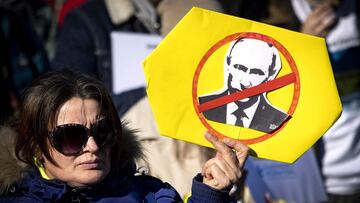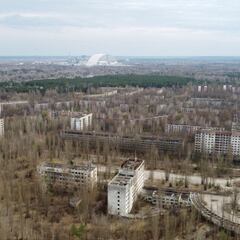Why is Russia interested in controlling nuclear power plants in Ukraine?
There are several theories as to why Russia is capturing Ukrainian nuclear power plants, a move that is causing grave concern around the world.

Ukraine has 15 operable nuclear reactors located at four plants spread across the country and four decommissioned reactors at Chernobyl, site of the worst manmade disaster. Invading Russian forces have now taken control of Chernobyl and Europe’s largest nuclear power plant Zaporizhzhia in southern Ukraine.
Russia has not said why they have taken control of the two sites but there are theories abound. The action has caused alarm and increased fears of a nuclear accident with would know no borders.
Also see:
- The prospect of a nuclear meltdown at Zaporizhzhia nuclear power plant
- Chernobyl, the worst manmade disaster
- Where are Europe's nuclear power plants?
- Why do we need nuclear power plants?
Chernobyl gives Russia direct access to Kiev
One of the first targets Russian troops captured upon invading Ukraine was the decommissioned Chernobyl nuclear power plant. The facility is located 10 miles from the Belarussian border within a 1,660 square mile exclusion zone, the majority of which is located in Ukraine. Control of the largely uninhabited area gives the Russian forces the ability to approach Kyiv, the Ukrainian capital from the northwest along the shortest route without having to cross the Dnieper River on hostile territory.
This was most likely the reasoning behind capturing the site of the 1986 nuclear disaster where radiation levels are considered tolerable for a limited amount of time. But Evelyn Farkas, deputy assistant secretary of defense for Russia, Ukraine, and Eurasia in the Obama administration says Moscow may want to secure the facility in the event of a protracted war in Ukraine. Insurgents could get their hands on radioactive material to make dirty bombs so "they certainly don’t want loose nuclear material floating around," she told NBC News.
Thousands of civilians are packing the train station in Zaporizhzhia, Ukraine, hoping to flee to safety after Russian troops occupied the nuclear power plant there. @kileycnn reports. pic.twitter.com/wHnGQsojTm
— CNN (@CNN) March 7, 2022
Zaporizhzhia nuclear power plant concerns international community
Director General Rafael Mariano Grossi of the International Atomic Energy Agency (IAEA) is “extremely concerned” about the developments at the Zaporizhzhia nuclear power which Russian forces captured in the early morning of 3 March. Their assault on the facility started a fire at a training facility and although none of the six reactors were damaged, interference by Russian commanders in the day-to-day operations could cause an unintended mishap.
The head of the international nuclear watchdog in a statement pointed to the occupation of the site contravening two of the seven indispensable pillars of nuclear safety and security he had laid out just days before. The operators of the facility are working under gunpoint and despite regular shift changes being allowed, they are short on food, lowering morale among staff. This violates Pillar 3 which states that workers must have “the capacity to make decisions free of undue pressure.”
#Ukraine informs IAEA that regular staff continue to operate #Zaporizhzhya Nuclear Power Plant, but plant management is now under orders from commander of Russian forces controlling site. DG @RafaelMGrossi deeply concerned with latest developments. https://t.co/TDZlLpV10f
— IAEA - International Atomic Energy Agency (@iaeaorg) March 6, 2022
Another disturbing development is reports from Ukraine that Russian forces have switched off mobile networks and the internet compromising normal channels of communication, without which authorities cannot gather reliable information on operations at the site. This goes against Pillar 7 which states “There must be reliable communications with the regulator and others.”
What does Russia want with the Zaporizhzhia nuclear power?
Ukraine is heavily reliant on nuclear power to supply its energy grid making up over 50 percent of the nation’s total generating capacity. The Zaporizhzhia facility is the largest in Europe containing six reactors that produce up to 6,000 megawatts a quarter of Ukraine’s overall power production. By taking control of the facility and others Russia will have the capability to turn the lights on and off in Ukraine.
Another reason that the site and other nuclear plants would be strategically important to Moscow are the transportation links to them according to Clint Watts, research fellow at the Foreign Policy Research Institute speaking on the Rachel Maddow Show. There have been reports of Russian tanks running out of gas as they push into Ukraine, the railheads at the nuclear power plants would allow the Russians to move their armor divisions around faster and without using up as much fuel.
There is also the psychological impact of using “fear as a weapon.” Possessing the nuclear assests allows them to “create disinformation, misinformation at home, scare their population.” Jon B Wolfsthal, a senior adviser to Global Zero in Washington, opined that maybe Putin needs the nuclear facilities to back up the story he’s been pitching that Ukraine was pursuing nuclear weapons as a justification for the illegal invasion.
Related stories
This is quite improbable and a blatant fabrication as Ukraine’s nuclear facilities and materials have been thoroughly inspected by the IAEA. Over the years since the last nuclear weapon left Ukraine in 1996 there have been no signs the country has had an interest in creating a military nuclear program.
⚡️Ukraine: Russians shoot fake video in Chornobyl.
— The Kyiv Independent (@KyivIndependent) March 7, 2022
Ukraine’s state company Energoatom said that after the Chornobyl plant staff refused to participate, the invaders filmed their troops dressed in the uniform of the French company Novarka, which had left the zone in 2020.
Wolfsthal wonders if attacking the facility in southern Ukraine was done by a rogue group of Russian soldiers, a prospect that he finds “almost more worrisome than if they were ordered to take the plant by force.” But if they were ordered to take control of the facility by force it “would indicate a level of recklessness and brinkmanship that we had not anticipated,” he wrote.


